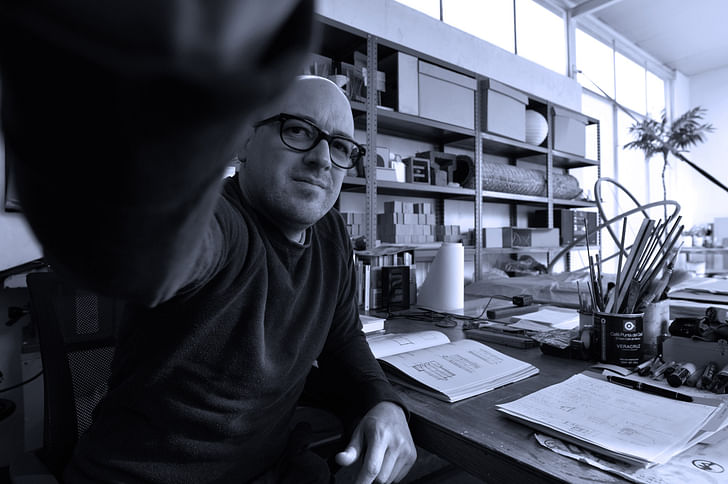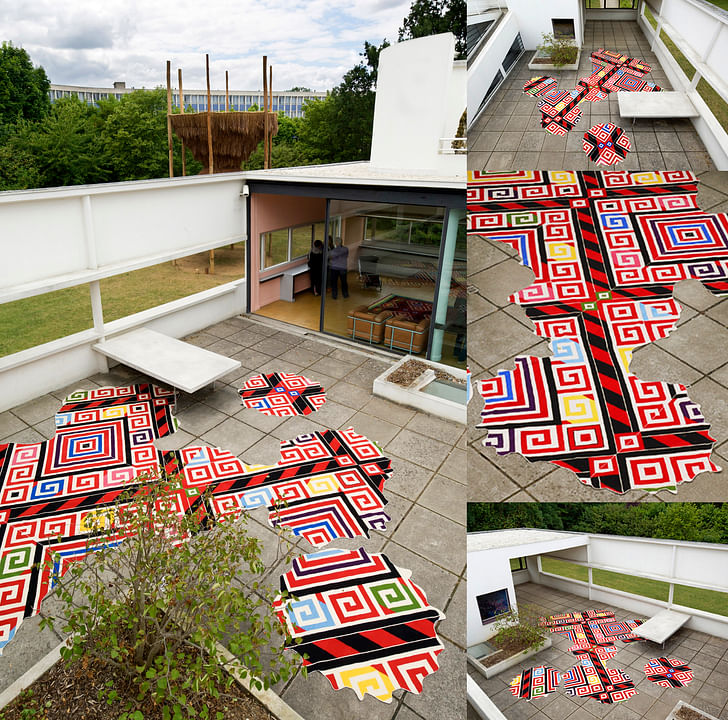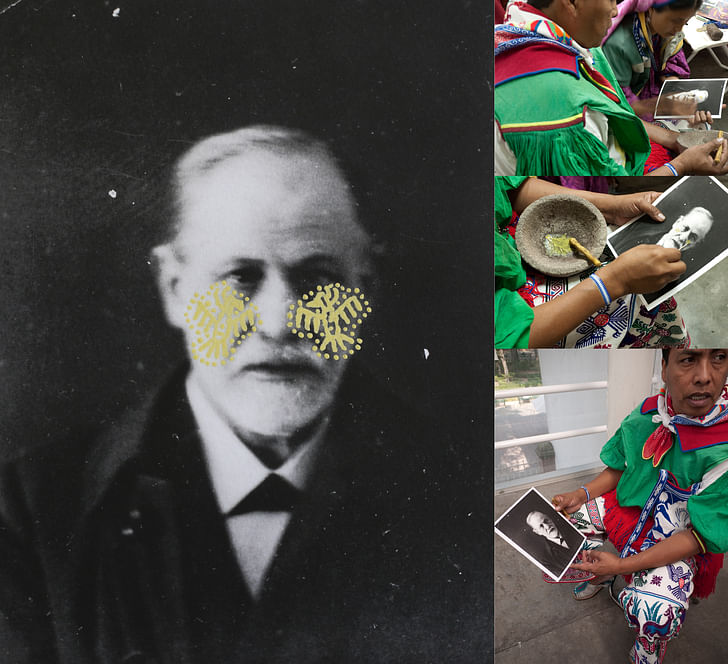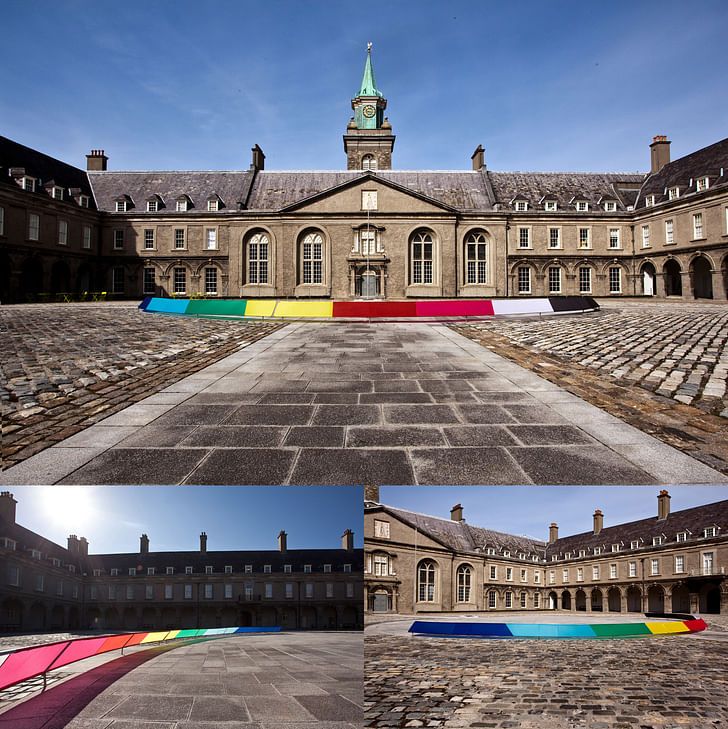

Working out of the Box is a series of features presenting architects who have applied their architecture backgrounds to alternative career paths.
In this installment, we're talking with artist and architecture theorist, Santiago Borja.
Are you an architect working out of the box? Do you know of someone that has changed careers and has an interesting story to share? If you would like to suggest an (ex-)architect, please send us a message.
Santiago Borja never intended to become an architect. As an artist naturally drawn to architectural installations and interventions, Borja figured that his best training would come from an architectural education, rather than what was offered by the pedagogy of art theory and practice. Getting an architecture degree without the looming specter of employment let Borja set his sights elsewhere, while simultaneously lapping up the procedural and academic rigor of an infamously generalist profession.

While much of Borja’s work is exhibited within the contemporary art world, its practice and application is foremost within architecture, often from the modern era. His interventions (also discussed in our recent feature on architectural preservation and historicism) stage sculptural adjustments or additions to a space, often spaces of preexisting cultural or historical prominence – like London's Freud Museum or the Irish Museum of Modern Art in Dublin. The result is a remixed spatial and cultural experience, meant to be physically encountered by visitors to the original space. These interventions are then documented through a variety of media to be exhibited within the contemporary art scene, the world-over.

Where did you study architecture?
I studied architecture in Mexico City at the Universidad Iberoamericana. A school meant to be more focused on design than the constructive aspects of architecture. Prior to that I studied for a year at the National School Of Visual Arts (at UNAM), but was kind of disappointed with the overall program and pedagogical approach there, so I decided to study architecture instead, feeling that it would give me a better professional background even though I already knew I wanted to be an artist and not an architect. I still believe it was a sound choice, allowing me to be a permanent outsider, something I feel has given me a particular identity. Later on I completed an MFA in Paris, where the focus was on art theory instead of art practice.
At what point in your life did you decide to pursue architecture?
It was quite late, probably the last year of high school. I could also say, even if it’s kind of a cliché, that at 17 I went on a back-packing trip in Europe that completely changed my perspective on things, and centered my attention on the arts. So coming back to Mexico, I thought I could start visual arts and architecture at the same time, but later on dropped visual arts and stayed only in architecture. At the time I became friends with a very interesting group even though I never thought of becoming an architect, I did enjoy quite a lot being an architecture student.of students of architecture from UNAM called Taller X. They were producing all kinds of different events and publications at the edge of art and architecture. They were witty and resourceful; it was an exciting time. I also started doing anonymous art installations by myself at the school of architecture I attended: an 8 feet tall ball made of human hair, another one with miles of rope, etc. So even though I never thought of becoming an architect, I did enjoy quite a lot being an architecture student.

When did you decide to stop pursuing architecture? Why?
I guess the last question answers this one also. But having said that, my relationship with architecture has gone on and off for some time now. I guess I have never stopped thinking of architecture, and have always been drawn to looking at buildings. The fact that I have never built or designed anything doesn’t really make a difference for me. In general, I enjoy much better visiting an interesting built site than an art exhibition, for example.
I’m trying to make art (something alive and ambiguous) again from institutionalized cultureOn the other hand, I have a very wandering mind and I am curious about many things, so I guess that I could have never fixed myself in the one thing, my projects are very distinct from one another, even if through time you can find some strong recurrences. Finally you have the construction conditions in Mexico, something that seriously put me off.
Designing is just like being in an ivory tower, and then you have the real conditions where things are done. Here in Mexico the conditions twenty years ago were pretty bad. I think it’s gotten better in the last few years, but you used to have underage people working at the construction sites, without protection or insurance or legal contracts, they used to work in the worst conditions. And of course, when you start building and you are made responsible for a site, you have to become a kind of nasty foreman. I just didn’t have the stomach for that. Now, big companies are running more construction, I’m not sure if things have really improved for the workers, but I have the impression that the conditions tend to be more civilized. Before it was quite wild, just hiring a bunch of day-laborers and putting them to work.

Describe your current profession.
I coproduce art exhibitions in museums and galleries, but I tend more and more to use different sites that already have cultural interest, such as the Freud Museum or the Villa Savoye. These places that are not really spaces consecrated to contemporary art, they provide me with the basic material I work with in order to produce projects that are very much iconic architecture has provided me with very rich material to work with, since it is both rooted in reality and in the symbolic domain.site-specific. The experiences I produce in those places, they’re then transposed to the contemporary art world. The people that go to the Villa Savoye or the Freud Museum, they are not particularly interested in art necessarily, and mostly they are astonished by what they see there. So I do my project, I document, register, etc., and all this is then shown in a contemporary art context, where I guess my public really is.
So the experience is transposed from the site to the exhibition space through photos, films, or objects, constructing a very specific sort of narrative. I could also say each project attracts a different kind of people. So even if at the moment I work in the contemporary art realm, as time goes by I’m getting more and more uncomfortable with being part of it. In my mind I’m kind of drifting apart from this, since I’m not really interested in its main operations, such as producing shows per se or being part of the art market. I guess I’m naturally drawn to a more academic approach to things, where the aesthetic experience can also produce knowledge in a broader sense. My practice is more about raising questions and building alternatives, than producing art objects.

To put it bluntly, I would say that I work with cultural heritage, material and immaterial, and I’m trying to make art (something alive and ambiguous) again from institutionalized culture (static and unquestionable objects). I believe that iconic architecture has provided me with very rich material to work with, since it is both rooted in reality and in the symbolic domain. And because I’m interested in cultural heritage, I’m also crisscrossing my practice with other disciplines, most specifically anthropology and psychology. But still, it is the contemporary art world that best receives what I produce, so I guess I have this paradoxical relationship with it.
there is no such thing as a single contemporary art world. Nowadays there are so many ways to understand art as people practicing.On the other hand, and to finish with this point, I’m a visiting teacher at the ESAY, the school of visual arts in Merida in the Yucatan Peninsula. This is an important activity for me, especially since the art school is located quite remotely from what could be considered the contemporary art center. In my opinion, the kind of questions that are raised there, are very different from the questions artists would be raising in New York or Paris, and they give me more reasons to think that there is no such thing as a single contemporary art world. Nowadays there are so many ways to understand art as people practicing.
What skills did you gain from architecture school, or working in the architecture industry, that have contributed to your success in your current career?
Well on the one hand, I think I have a sense of structural logic that most artists lack. They imagine things they have no clue how to build. Having said that, you could maybe say the same thing about architects...
This same structural logic informs the conceptual or ideological aspect of my practice. On the other hand, maybe this is a polemical answer, but I have the feeling that having an architectural background has helped me understand differently the authorship of a piece. I believe more in collaboration, and I’m well aware of the other people that work on each different project. I don’t pretend to be the one.
I also have the feeling that what I do, even if it works through a symbolic language, is more rooted in reality than contemporary art practices. I liked to work with things that are real, that have informed our collective unconscious, and not necessarily with imagined fantasies.


Do you have an interest in returning to architecture?
I think I’m still working in the domain of architecture, maybe in an oblique way I grant you that, but I have the feeling I never left. I also believe that my work as an artist is starting to have an impact in the architectural world, and just to mention a couple of examples, I’m working at the moment for a project with The New Institute (For Architecture) in Rotterdam and on a book on architecture to be published by Cabinet Magazine. That book will be co-edited with Sina Najafi and Christopher Turner, and will take an interesting look at Modern Architecture and its alternative narratives that, so far, have been left aside.

Former Managing Editor and Podcast Co-Producer for Archinect. I write, go to the movies, walk around and listen to the radio. My interests revolve around cognitive urban theory, psycholinguistics and food.Currently freelancing. Be in touch through longhyphen@gmail.com
1 Comment
The installations are refreshing - they react to the architecture without following an architectural logic of construction or space-making. Even the large ones appear to have the feel of handcrafted objects. But they still feel like fixtures on site rather than furniture or something movable. Very nice.
I'd be interested to know how he comes up with a concept for an installation, and how that's developed. I guess I'm wondering how "process" as discussed on another thread fits into his work. To me these look free of the forced logic which constrains a lot of architects working in installation. My compliments to the artist!
Block this user
Are you sure you want to block this user and hide all related comments throughout the site?
Archinect
This is your first comment on Archinect. Your comment will be visible once approved.